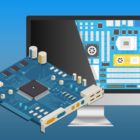Troubleshooting Framerate and Display Issues in DOSBox
![]() Everyone loves a bit of retro gaming every now and then, right? Having grown up in the 90s, the old-school PC games of the era are always going to hold a special place in my heart, and they’re always going to be something I enjoy playing. Unfortunately, for nostalgia buffs, technology’s come a very,very long way since the days of the Microsoft Disc Operating System. As a result, most older games don’t exactly play nice with modern hardware and software, and running them in compatibility mode isn’t often enough.
Everyone loves a bit of retro gaming every now and then, right? Having grown up in the 90s, the old-school PC games of the era are always going to hold a special place in my heart, and they’re always going to be something I enjoy playing. Unfortunately, for nostalgia buffs, technology’s come a very,very long way since the days of the Microsoft Disc Operating System. As a result, most older games don’t exactly play nice with modern hardware and software, and running them in compatibility mode isn’t often enough.
Enter DOSBox; An MS-DOS emulation platform. It allows you to play pretty much any of the titles from the older computing generation by creating a software environment in which it virtualizes the hardware and application environment of yesteryear. All you really need to know about it is that it lets you play older titles on newer systems, truth be told.
Oh, and you should probably give yourself a refresher course on MS-DOS commands- there’s a tutorial notepad file included with the DOSBox install file. If you’re downloading DOSBox, it’s worth a read.
Anyway, as is the case with most applications- particularly emulation platforms- DOSBox doesn’t work perfectly all the time. Most commonly, you’re going to see some frame-rate issues and graphical glitches. There are a number of reasons that this might happen, but usually it’s because your system is displaying a frame-rate that’s too high for the game to handle- as a result, you get chopping, skipping, and generally poor image quality.
Frame-Rate Fixes
In order to keep a game’s frame-rate at a level that’s manageable for the application, you’re basically going to need to tone down the power of your system. There are a few ways you can do this- first and foremost, you can try changing the core affinity of either DosBox or the game you’re trying to run to a single processor on multi-core systems.
The easiest way to fix your frame-rate issues, however involves a quality known as CPU Cycles. While running a program through DOSBox, it’ll display the cycles at the top of the screen. First, try increasing the cycles by pressing CTRL and F12. Continue doing this for a time. If you don’t see your problems disappear, your game’s probably having trouble because the CPU is going too fast for it. Use CTRL+F11 to reduce it.
Once you’ve figured out the ‘sweet spot’ for a particular game, you can open up the DOSBox configuration file, and change DOSBox’s configuration file by opening up “Options” in the DOSBox folder, and changing the value you see next to “cycles.”
Alternatively, you can simply keep track of which games require different CPU speeds, and enter in the command “cycles=(value you’re setting the cycles to).” Finally, you can try enabling frame-skip. Simply type either frame-skip 1 or frame-skip 2. Again, you can change all of this by editing the configuration file (DOSBox Options) as well.
If, even with all of the above, you’re still running into frame rate issues, it may well be that your system’s having trouble running DOSBox due to a lack of computing resources. Consider what other programs are running when you open the emulator.
Troubleshooting Display Issues
Due to the difference between older computer screens and modern screens, it’s fairly common for DOSBox virtualization to experience a few display issues here and there. Commonly, you’re going to either notice the game’s having trouble refreshing the display (leading to a number of hangups), or simply crash altogether. You might also notice that the images on-screen look either warped or stretched.
Addressing the ‘distorted images’ issue is pretty simple- simply make certain that aspect ratio correction is enabled. (“aspect”) in the config file. As for the refresh rate and crash issues, try modifying the output from “Surface” to either OpenGL(output=openglnb) or DirectDraw(output=ddraw). In order to do this, open up the configuration file, and look for “output,” under the file’s SDL section.
Finally, as a general rule, you should run the install file for games that you’re playing in DOSBox (Typically “install.exe” or “setup.exe”). The reason for this is that DOSBox doesn’t always correctly set the graphics mode for a particular application. By running the application via the setup utility, you’re basically making certain that it uses the correct graphics mode.
Color Palette Problems
DOSBox games generally use an older color palette from the rest of Windows. If you’re running it as a full-screen application, Windows is likely to switch to a different ‘color mode.’ Trouble is, sometimes Windows has issues switching back to that mode if you, for some reason, return to the default settings while you’ve got the application open. Make sure you’re not running any programs that are likely to ‘interrupt’ DOSBox by taking focus away from the application (such as pop-up windows in instant messaging software), and avoid alt+tabbing out, if you can help it.
I won’t lie, this article doesn’t cover every single issue that exists with DOSBox, and I’m sure there are even a few graphical glitches I’ve not addressed. Any of you folks out there experienced a graphical issue that wasn’t on the list, drop me a line, and I’ll do what I can to help you out.

















One thought on “Troubleshooting Framerate and Display Issues in DOSBox”